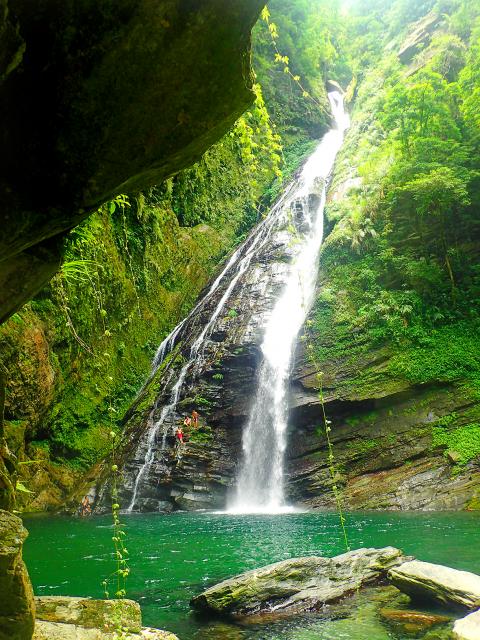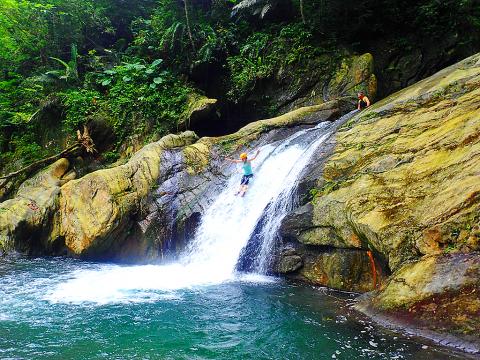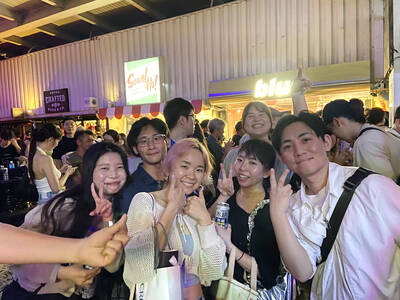Taiwan has some spectacular coastal scenery and plenty of amazing waterfalls, but it’s unusual to enjoy both on the same trip. The Suhua Highway (蘇花公路), however, has both, and just a two-hour drive from Taipei. Despite the hassles of traveling along it, the highway between Yilan County’s Suao Township (蘇澳) and Hualien has perhaps the most spectacular coastal scenery in Taiwan, and when friends come to visit, I almost always tack on a drive along it either before or after the compulsory trip to Taroko Gorge. ah
The 118km-long Suhua Highway originated as one of three routes created to gain access to the interior and east coast of the island. The other two are the original Batongguan Old Trail (八通關古道) in Nantou and Hualien counties and the Jinshueiying Ancient Trail (浸水營古道).
The three routes were established after 54 shipwrecked Japanese sailors from the Ryuku Islands were killed by Aborigines in 1871 near the southern tip of the island. The Japanese used the incident to launch a brief invasion of Taiwan later the same year and, finding the feat unexpectedly easy, fomented plans for a second invasion attempt 14 years later, which was successful.

Photo: Richard Saunders
In the 1920s, the Japanese started building a gravel road (following a different, parallel route from the Qing-era path), and it was that which eventually became today’s Suhua Highway.
For decades after it opened to cars, the road was a one-lane affair, and vehicles had to take it in turns, traveling along sections and queuing at designated places to wait while traffic in the opposite direction was allowed through. I can attest that as late as the 1990s, several long tunnels were still one-lane affairs, and drivers faced an interminably long wait if they missed a green traffic light.
Things have improved greatly in the two decades since, and the current Suhua Highway Improvement Project (started in 2011 and slowly opening in sections) is seeing much more of the highway being burrowed into the cliffs, away from the hazards of falling rocks and landslides, as eight new tunnels are finished.

Photo: Richard Saunders
The first tunnels are already open, between Suao and Nanao (南澳) townships, and the old road between the towns (which can still be followed) is a delight to motor along nowadays, as there’s relatively little traffic.
Although wider and safer than a couple of decades ago, the Suhua Highway remains probably the riskiest of Taiwan’s major highways. It is fairly narrow in many places, often with a sheer drop into the ocean, and, to make matters worse, heavy lorries and other big vehicles continue to zoom along it at often unreasonable speeds, so driving it can be a nerve-wracking experience (now the summer holidays are underway, I wouldn’t dream of attempting it on the weekend). If you get good weather, though, it’s one of the nation’s most exhilarating drives.
WATERFALLS

Photo: Richard Saunders
There are at least five waterfalls either just off or close to the highway, and although two of them, including the wonderful upper Jinyue Waterfall (金岳瀑布), can only be reached by a river trace, the others are easy enough to visit.
The lower fall at Jinyue (which doubles as possibly Taiwan’s highest and scariest natural waterslide) is just a couple of minutes from the road turning off the Suhua Highway at Nanao in the direction of Jinyue (金岳). Follow the road up beside the stream, and leave your vehicle in the car park at the end. Walk down to the stream, and paddle up to the base of the waterfall, just a minute or two upstream.
From here, it’s an hour or so up to the main fall, a dramatic white spout plunging 30 meters into a huge pool. It’s a short river trace, and not too difficult, but don’t attempt it without experience and all the proper river tracing gear. It’ll be heaving with river tracers at weekends this time of year.
South of Nanao, the cliff scenery continues, broken only briefly as the road descends several times to villages nestled along the alluvial plains at the mouths of rivers that cut their way through the central mountains and empty into the Pacific.
The twin townships of Yilan County’s Aohua (澳花) and neighboring Heping (和平) lie on one of these wide river mouths, but the beauty of area is ruined by a hideous power station and cement factory.
So before reaching Heping (surely the low point of any trip along the Suhua Highway) turn right into the little aboriginal village of Aohua for a short but memorable detour to perhaps the finest waterfall on the east coast.
Aohua is an Atayal community and the authorities here, as in so many places, have prettified it by adding colorful, tourist-pleasing murals of happy Aborigines and their wares. A kilometer or so off the highway, pass through Aohua Village, keeping to the road past the sports field, and soon afterwards, a large boulder inscribed with red-painted characters points the way towards Aohua Waterfall, up the big valley ahead.
The road follows the wide stream up, and although it’s now unsurfaced, its condition is good, and two-wheel drive cars will have no problem unless it’s very wet. If you’re riding a scooter, carry on all the way to the bridge over the stream, otherwise park the car beside the road in another kilometer or so (there’s enough room for six or seven cars), and walk the final 15 minutes to the little bridge, just before the stream forks into two branches, each cascading down from the high mountains in front.
Follow the track beside the right-hand branch of the stream, and it soon becomes a concrete-stepped path. Climb over a gentle rise and then down the other side to the huge, deep plunge pool at the foot of spectacular Aohua Waterfall (澳花瀑布). This 50 meter-high plunge is a very impressive sight. Even more tempting at this time of year, it falls into a huge, cold plunge pool perfect for swimming.
Richard Saunders is a classical pianist and writer who has lived in Taiwan since 1993. He’s the founder of a local hiking group, Taipei Hikers, and is the author of six books about Taiwan, including Taiwan 101 and Taipei Escapes. Visit his Web site at www.taiwanoffthebeatentrack.com

Late last month Philippines Foreign Affairs Secretary Theresa Lazaro told the Philippine Senate that the nation has sufficient funds to evacuate the nearly 170,000 Filipino residents in Taiwan, 84 percent of whom are migrant workers, in the event of war. Agencies have been exploring evacuation scenarios since early this year, she said. She also observed that since the Philippines has only limited ships, the government is consulting security agencies for alternatives. Filipinos are a distant third in overall migrant worker population. Indonesia has over 248,000 workers, followed by roughly 240,000 Vietnamese. It should be noted that there are another 170,000

Hannah Liao (廖宸萱) recalls the harassment she experienced on dating apps, an experience that left her frightened and disgusted. “I’ve tried some voice-based dating apps,” the 30-year-old says. “Right away, some guys would say things like, ‘Wanna talk dirty?’ or ‘Wanna suck my d**k?’” she says. Liao’s story is not unique. Ministry of Health and Welfare statistics show a more than 50 percent rise in sexual assault cases related to online encounters over the past five years. In 2023 alone, women comprised 7,698 of the 9,413 reported victims. Faced with a dating landscape that can feel more predatory than promising, many in

“This is one of those rare bits of TikTok fitness advice with a lot of truth behind it,” says Bethan Crouse, performance nutritionist at Loughborough University. “Sometimes it’s taken a bit too literally, though! You see people chugging protein drinks as they’re scanning out of their gym.” Crouse recommends the athletes she works with consume 20-30g of protein within 30-60 minutes of finishing a resistance training session. “The act of exercising our muscles increases the breakdown of muscle proteins,” she says. “In order to restore, or hopefully improve them — and get gains such as increased muscle mass or strength —

“Far from being a rock or island … it turns out that the best metaphor to describe the human body is ‘sponge.’ We’re permeable,” write Rick Smith and Bruce Lourie in their book Slow Death By Rubber Duck: The Secret Danger of Everyday Things. While the permeability of our cells is key to being alive, it also means we absorb more potentially harmful substances than we realize. Studies have found a number of chemical residues in human breast milk, urine and water systems. Many of them are endocrine disruptors, which can interfere with the body’s natural hormones. “They can mimic, block